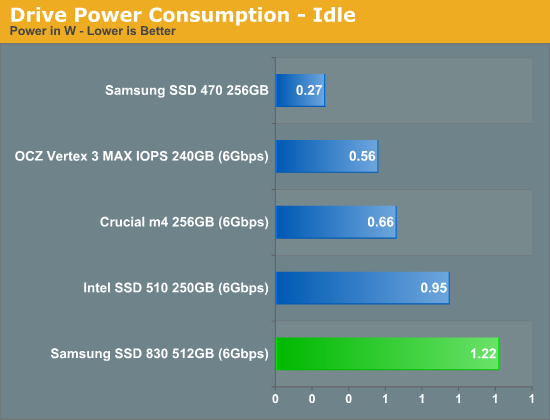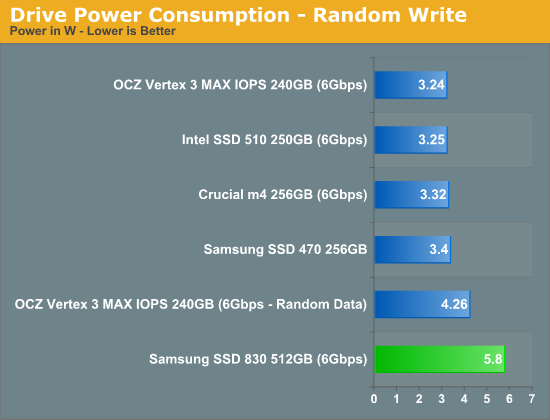The Samsung SSD 830 Review
by Anand Lal Shimpi on September 24, 2011 1:02 AM EST- Posted in
- SSDs
- Storage
- Samsung
- pm830
- Samsung SSD 830
Power Consumption
Samsung sampled the 512GB version of the SSD 830 so it's unclear how much the sheer number of NAND die impacts power consumption here. At 1.22W while idle the 830 seems to draw 28% more power than the Intel SSD 510. Under load that gap drops to only 14% during sequential writes but skyrockets to 70% under random writes. Again part of this is likely due to the higher capacity. Until we get lower capacity drives it's impossible to tell how much the power consumption story will change.













99 Comments
View All Comments
Herp Derpson - Saturday, September 24, 2011 - link
Anand, it would be very interesting to read about hardware AES encryption in SSDs - how do you use it and how does it affects performance.juhatus - Saturday, September 24, 2011 - link
Yeap, I heard that AES basicly kills all-compressing Sandforce's?Maybe test with win7's bitlocker?
Ryan Smith - Saturday, September 24, 2011 - link
Only if you leave encryption up to the OS. With a SF SSD you should be leaving it up to the drive - AES encryption is basically free on those drives, they just run the cypher after dedupe and compression.zanon - Saturday, September 24, 2011 - link
There are plenty of valid reasons though not to leave encryption up to the drive, ranging from a need for other features/management (like multiple factors) to just plain not trusting encryption where no source review or updates are available. Perhaps most importantly is the simple observation that it's probable that the vast majority of FDE users are using either software (Truecrypt/PGP or whatever) or OS level solutions.Given that, I think it's a valid situation to consider, along with filesystem-level compression.
docbones - Monday, October 10, 2011 - link
I would love to see a benchmark article on whole disk encryption across drive types. (especially interested in how does the seagate hybrids do)iwodo - Saturday, September 24, 2011 - link
was it tested with new firmware?Anand Lal Shimpi - Saturday, September 24, 2011 - link
The initial graphs used the older fw but after realizing the mistake I updated the numbers to the latest FW0009 numbers, so yes :)Take care,
Anand
Beenthere - Saturday, September 24, 2011 - link
I'd be interested in a number of SSDs if they ever sort out the reliability and compatibility issues. I had hoped by now this would have happened but clearly it has not. This is like OJT for SSD makers I guess.soliozuz - Saturday, September 24, 2011 - link
It's funny you mentioned that because I think you just jinxed both companies. it seems that Apple will no longer be relying on Samsung for it's Nand Flash and etc. Now the reasons as to why they would dump someone as reliable as Samsung is beyond me.Source: http://www.techspot.com/news/45591-apple-decreasin...
In regards to the SSD, I must admit, as great of a thing they have done with this drive, I kind of was left expecting more. Samsung made a statement last year releasing a SATA II SSD especially with the kind of power consumption they had on it. I think that's key for future products.
jwilliams4200 - Saturday, September 24, 2011 - link
If you read the source article (Digitimes), it is stated that Apple is apparently diversifying its suppliers from Samsung because of patent disputes with Samsung.